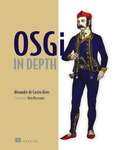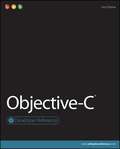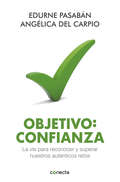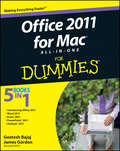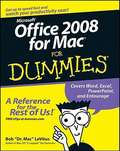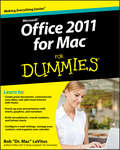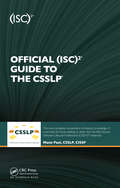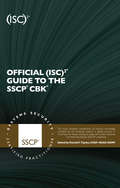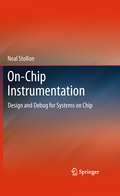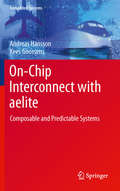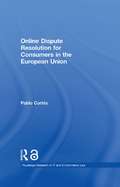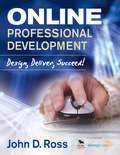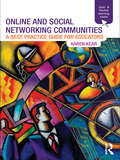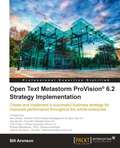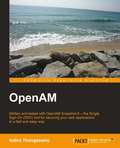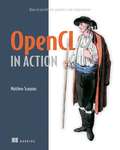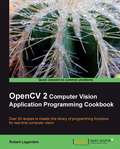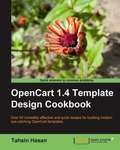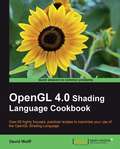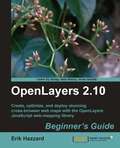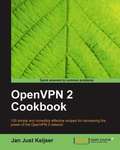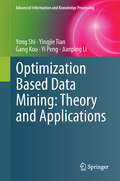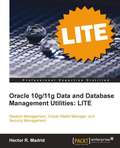- Table View
- List View
OSGi in Depth
by Alex AlvesSummaryOSGi in Depth shows Java developers how to develop to the OSGi Service Platform Enterprise specification, an emerging Java-based technology for developing modular enterprise applications.About the TechnologyOSGi is a mature framework for developing modular Java applications. Because of its unique architecture, you can modify, add, remove, start, and stop parts of an application without taking down the whole system. You get a lot of benefit by mastering the basics, but OSGi really pays off when you dig in a little deeper.About this BookOSGi in Depth presents practical techniques for implementing OSGi, including enterprise services such as management, configuration, event handling, and software component models. You'll learn to custom-tailor the OSGi platform, which is itself modular, and discover how to pick and choose services to create domain-specific frameworks for your business. Also, this book shows how you can use OSGi with existing JEE services, such as JNDI and JTA.Written for Java developers who already know the basics, OSGi in Depth picks up where OSGi in Action leaves off. Purchase of the print book comes with an offer of a free PDF, ePub, and Kindle eBook from Manning. Also available is all code from the book. What's InsideDeep dives into modularization, implementation decoupling, and class-loadingPractical techniques for using JEE servicesCustomizing OSGi for specific business domains=============================================Table of ContentsOSGi as a new platform for application developmentAn OSGi framework primerThe auction application: an OSGi case studyIn-depth look at bundles and servicesConfiguring OSGi applicationsA world of eventsThe persistence bundleTransactions and containersBlending OSGi and Java EE using JNDIRemote services and the cloudLaunching OSGi using start levelsManaging with JMXPutting it all together by extending Blueprint
Objective-C
by Jiva DevoeA soup-to-nuts guide on the Objective-C programming languageObjective-C is the language behind Cocoa and Cocoa Touch, which is the Framework of applications written for the Macintosh, iPod touch, iPhone, and iPad platforms. Part of the Developer Reference series covering the hottest Apple topics, this book covers everything from the basics of the C language to advanced aspects of Apple development. You'll examine Objective-C and high-level subjects of frameworks, threading, networking, and much more.Covers the basics of the C language and then quickly moves onto Objective-C and more advanced topicsDraws from the author's first-hand experience garnered while developing applications for the Mac and iPhone OS platformsIncludes chapters on classes, memory management, threads, and the Foundation frameworkAlso covers advanced topics like protocols, categories, associated objects, and blocksFeaturing real-life examples drawn from the author's experience, Objective-C offers an insider look at this amazing programming language.
Objetivo: confianza
by Edurne Pasabán Angélica Del Carpio«Edurne y Angélica reflexionan en este libro sobre algo que es de gran actualidad para las empresas: la aceptación de la inseguridad y del cambio permanentes. Y cómo, a través de la confianza, los valores de innovación y flexibilidad que pedimos en las empresas, nos los debemos pedir a nosotros mismos para apasionarnos con lo que hacemos.»Josep Moragas, consejero delegado, ACC1Ó«Esta experiencia de coaching singular, es una lección de cómo la confianza en lo que hacemos, nuestras competencias y la pasión nos pueden ayudar a tomar decisiones creativas e innovadoras en situaciones de crisis. ¡Gracias, Edurne y Angélica, por vuestra generosidad al compartirlo!»Pilar Rojo, executive coa ch, profesora de dirección de personas y coaching del IE Business School«Una muestra real del arte del coaching, que nos aporta una nueva perspectiva de la responsabilidad y del compromiso. Este es un libro práctico, cercano y directo con el que se identificarán personas y organizaciones que quieran afrontar el futuro de manera constructiva.»Manuel Carreras Fisas, presidente de Sport Cultura Barcelona y coach por el IE Business School
Office 2011 for Mac All-in-One For Dummies
by James Gordon Geetesh BajajGet up to speed on the revolutionary changes in Office for the Mac The 2011 version of the Microsoft Office productivity suite for the Mac sports major changes from what Mac users are accustomed to. This soup-to-nuts guide gets the Mac crowd up to date quickly and easily. Individual minibooks thoroughly cover the Project Gallery, Word, Excel, PowerPoint, Outlook (new for Mac), and the Project Center. You'll learn how the new Office integrates with the Windows version, how to use and customize the new Ribbon interface, and much more. Office for Mac is the most popular office productivity suite for the Mac, used by 1. 5 to 2 million people The new version includes new features such as the Ribbon interface, Outlook (which replaces Entourage), and greater integration with the Windows version Covers everything you'll want to know about the Project Gallery, Word, Excel, PowerPoint, Outlook, and the Project Center With Office 2011 for Mac All-in-One For Dummies, you'll be ready to use the newest version of Office like a pro.
Office 2011 for Mac For Dummies
by Bob LevitusGet started with Office 2011 for Mac and discover the creative possibilitiesThe leading suite of productivity software for the Mac, Microsoft Office helps users complete common business tasks, including word processing, e-mail, presentations, financial analysis, and much more. Office 2011 for Mac For Dummies is the perfect companion for Microsoft Office for Mac users upgrading to the newest version, new computer users, and those who may have switched from the Windows version of Office. Written by one of the most popular gurus in the Mac community, Bob "Dr. Mac" LeVitus, the book explains every 2011 application so you can become savvy in no time.Addresses ways to refine and edit documents with WordExplains how to add pizzazz to your slide shows with PowerPointGuides you through crunching numbers and data with ExcelDemonstrates how to send, receive, and manage your e-mail on OutlookEncourages you to organize your contact information, schedule your time, and moreWith Office 2011 for Mac For Dummies, you'll learn everything you need to know to make the most of Office on your Mac!
Office 2011 for Mac For Dummies
by Bob LeVitusGet started with Office 2011 for Mac and discover the creative possibilities The leading suite of productivity software for the Mac, Microsoft Office helps users complete common business tasks, including word processing, e-mail, presentations, financial analysis, and much more. Office 2011 for Mac For Dummies is the perfect companion for Microsoft Office for Mac users upgrading to the newest version, new computer users, and those who may have switched from the Windows version of Office. Written by one of the most popular gurus in the Mac community, Bob "Dr. Mac" LeVitus, the book explains every 2011 application so you can become savvy in no time. Addresses ways to refine and edit documents with Word Explains how to add pizzazz to your slide shows with PowerPoint Guides you through crunching numbers and data with Excel Demonstrates how to send, receive, and manage your e-mail on Outlook Encourages you to organize your contact information, schedule your time, and more With Office 2011 for Mac For Dummies, you'll learn everything you need to know to make the most of Office on your Mac!
Office 365 in Business
by David Kroenke Donald NilsonDiscover the Office option every business can affordNow your business can benefit from sophisticated communication and collaboration services fully integrated with Microsoft Office products. Once limited to companies large enough to afford data centers and the expensive IT staff to support them, these services can now be yours, and this book shows you how. Each chapter begins with a common business problem you've most likely faced, followed by the Office 365 solution. You'll learn to share documents, secure your communications, manage and share calendars and tasks, conduct video meetings, and give your business the edge it deserves.Teaches you how your business, large or small, can benefit from Office 365 Explains how to take advantage of Exchange Online, Lync Online, and SharePoint Online Shows you what makes Office 365 so affordable and why it doesn't require an IT staff Highlights what constitutes successful collaboration and how to facilitate it Explores specific Office 365 solutions for familiar business issues Addresses how to conduct video conferences, schedule meetings, set up discussions, and make remote PowerPoint presentations with Office 365With this book, you'll discover how Office 365 can benefit your business every day of the year!
Official ((isc)2 Press Ser.)
by Mano PaulAs the global leader in information security education and certification, (ISC)2 has a proven track record of educating and certifying information security professionals. Its newest certification, the Certified Secure Software Lifecycle Professional (CSSLP) is a testament to the organization's ongoing commitment to information and software security
Official ((isc)2 Press Ser.)
by R Anderson J D DewarThe (ISC) Systems Security Certified Practitioner (SSCP ) certification is one of the most important credentials an information security practitioner can have. Having helped thousands of people around the world obtain this distinguished certification, the bestselling Official (ISC)2 Guide to the SSCP CBK has quickly become the book that many of
On-Chip Instrumentation
by Neal StollonThis book provides an in-depth overview of on chip instrumentation technologies and various approaches taken in adding instrumentation to System on Chip (ASIC, ASSP, FPGA, etc.) design that are collectively becoming known as Design for Debug (DfD). On chip instruments are hardware based blocks that are added to a design for the specific purpose and improving the visibility of internal or embedded portions of the design (specific instruction flow in a processor, bus transaction in an on chip bus as examples) to improve the analysis or optimization capabilities for a SoC. DfD is the methodology and infrastructure that surrounds the instrumentation. Coverage includes specific design examples and discussion of implementations and DfD tradeoffs in a decision to design or select instrumentation or SoC that include instrumentation. Although the focus will be on hardware implementations, software and tools will be discussed in some detail.
On-Chip Interconnect with aelite
by Andreas Hansson Kees GoossensThe book provides a comprehensive description and implementation methodology for the Philips/NXP Aethereal/aelite Network-on-Chip (NoC). The presentation offers a systems perspective, starting from the system requirements and deriving and describing the resulting hardware architectures, embedded software, and accompanying design flow. Readers get an in depth view of the interconnect requirements, not centered only on performance and scalability, but also the multi-faceted, application-driven requirements, in particular composability and predictability. The book shows how these qualitative requirements are implemented in a state-of-the-art on-chip interconnect, and presents the realistic, quantitative costs.
Online Dispute Resolution for Consumers in the European Union (Routledge Research in Information Technology and E-Commerce Law)
by Pablo CortésA PDF version of this book is available for free in open access via www.tandfebooks.com as well as the OAPEN Library platform, www.oapen.org. It has been made available under a Creative Commons Attribution-Non Commercial-No Derivatives 3.0 license and is part of the OAPEN-UK research project. E-commerce offers immense challenges to traditional dispute resolution methods, as it entails parties often located in different parts of the world making contracts with each other at the click of a mouse. The use of traditional litigation for disputes arising in this forum is often inconvenient, impractical, time-consuming and expensive due to the low value of the transactions and the physical distance between the parties. Thus modern legal systems face a crucial choice: either to adopt traditional dispute resolution methods that have served the legal systems well for hundreds of years or to find new methods which are better suited to a world not anchored in territorial borders. Online Dispute Resolution (ODR), originally an off-shoot of Alternative Dispute Resolution (ADR), takes advantage of the speed and convenience of the Internet, becoming the best, and often the only option for enhancing consumer redress and strengthening their trust in e-commerce. This book provides an in-depth account of the potential of ODR for European consumers, offering a comprehensive and up to date analysis of the development of ODR. It considers the current expansion of ODR and evaluates the challenges posed in its growth. The book proposes the creation of legal standards to close the gap between the potential of ODR services and their actual use, arguing that ODR, if it is to realise its full potential in the resolution of e-commerce disputes and in the enforcement of consumer rights, must be grounded firmly on a European regulatory model.
Online Professional Development: Design, Deliver, Succeed!
by John D. RossMuch-needed direction for navigating online professional development Online professional development expert John D. Ross’s practical framework will help you ask the right questions and make sound development and purchasing decisions. Based on proven principles of professional learning and instructional design, he guides you through charting your course to success and provides a path to answering these fundamental questions: <p><p> Why do I need OPD? <p> How much does it cost? <p> How do I get started? <p> What does high-quality online learning look like? <p> What technologies are right for me? <p> Did it work?
Online and Social Networking Communities: A Best Practice Guide for Educators (Open and Flexible Learning Series)
by Karen KearOnline and Social Networking Communities is a professional guide written for educational practitioners and trainers who wish to use online communication tools effectively in their teaching. Focusing on the student experience of learning in online communities, it addresses ‘web 2.0’ and other ‘social software’ tools and considers the role these technologies play in supporting student learning and building learning communities. The guide offers: real-world case studies and quality research must-have lists of useful resources guidance on building and supporting online learning communities discussion of how collaborative learning can be assessed coverage of wikis, forums, blogging, instant messaging, Second Life, Twitter, desktop videoconferencing and social networking sites such as Facebook. Online and Social Networking Communities helps educators and trainers develop a critical approach by exploring online learning from both the student’s and educator’s perspective. This practical guide provides the tools to help develop confident and thoughtful online educators, able to create successful and enjoyable learning experiences for their students.
Ontologies in Urban Development Projects
by Jacques Teller Claudine Métral Christopher Tweed Gilles FalquetOntologies are increasingly recognized as essential tools in information science. Although the concepts are well understood theoretically , the practical implementation of ontologies remains challenging. In this book, researchers in computer science, information systems, ontology engineering, urban planning and design, civil and building engineering, and architecture present an interdisciplinary study of ontology engineering and its application in urban development projects. The first part of the book introduces the general notion of ontology, describing variations in abstraction level, coverage, and formality. It also discusses the use of ontologies to achieve interoperability, and to represent multiple points of view and multilingualism. This is illustrated with examples from the urban domain. The second part is specific to urban development. It covers spatial and geographical knowledge representation, the creation of urban ontologies from various knowledge sources, the interconnection of urban models and the interaction between standards and domain models. The third part presents case studies of the development of ontologies for urban mobility, urban morphological processes, road systems, and cultural heritage. Other cases report on the use of ontologies to solve urban development problems, in construction business models, building regulations and urban regeneration. It concludes with a discussion of key challenges for the future deployment of ontologies in this domain. This book bridges the gap between urban practitioners and computer scientists. As the essence of most urban projects lies in making connections between worldviews, ontology development has an important role to play, in promoting interoperability between data sources, both formal (urban databases, Building Integrated Models, Geographical Information Systems etc.) and less formal (thesauri, text records, web sources etc.). This volume offers a comprehensive introduction to ontology engineering for urban development. It is essential reading for practitioners and ontology designers working in urban development.
Open Text Metastorm ProVision® 6.2 Strategy Implementation
by Bill AronsonThis is both a practical and theoretical guide detailing how to deploy a successful ProVision® strategy, using a number of real business cases along the way. Unlike other architecture books, the approach is holistic - it looks at the whole lifecycle of building a business case, through to using the product. It combines a detailed understanding of the ProVision® toolset with a practical grasp of the business issues that affect the implementation of a successful strategy.If you are a business architect or CIO in a large organization who wants to implement a successful strategy using Open Text ProVision®, then this book is for you. It will also be of interest if you are an enterprise designer or architect. It might be that you already have working knowledge of ProVision®, but do not yet have the skill to implement it in the right context; this book will help you get there.
OpenAM
by Indira ThangasamyThis book is a step-by-step tutorial stuffed with practical, real-world examples. It is designed in such a way that if you are already familiar with OpenAM, you can easily skip to a later chapter without missing a beat. You should be able to quickly grasp the basic elements of OpenAM before moving on to the more advanced features and functionality. If you are a security architect or a solution developer responsible for the design and development of web-based enterprise applications that need to provide authentication, authorization, and audit facilities along with SSO capabilities, then this book is for you. You do not require any prior knowledge of OpenAM to read this book. Familiarity with Java will be helpful, but is not essential.
OpenCL in Action: How to accelerate graphics and computations
by Matthew ScarpinoSummaryOpenCL in Action is a thorough, hands-on presentation of OpenCL, with an eye toward showing developers how to build high-performance applications of their own. It begins by presenting the core concepts behind OpenCL, including vector computing, parallel programming, and multi-threaded operations, and then guides you step-by-step from simple data structures to complex functions.About the TechnologyWhatever system you have, it probably has more raw processing power than you're using. OpenCL is a high-performance programming language that maximizes computational power by executing on CPUs, graphics processors, and other number-crunching devices. It's perfect for speed-sensitive tasks like vector computing, matrix operations, and graphics acceleration.About this BookOpenCL in Action blends the theory of parallel computing with the practical reality of building high-performance applications using OpenCL. It first guides you through the fundamental data structures in an intuitive manner. Then, it explains techniques for high-speed sorting, image processing, matrix operations, and fast Fourier transform. The book concludes with a deep look at the all-important subject of graphics acceleration. Numerous challenging examples give you different ways to experiment with working code.A background in C or C++ is helpful, but no prior exposure to OpenCL is needed. Purchase of the print book comes with an offer of a free PDF, ePub, and Kindle eBook from Manning. Also available is all code from the book. What's InsideLearn OpenCL step by stepTons of annotated codeTested algorithms for maximum performance***********Table of ContentsPART 1 FOUNDATIONS OF OPENCL PROGRAMMINGIntroducing OpenCLHost programming: fundamental data structuresHost programming: data transfer and partitioningKernel programming: data types and device memoryKernel programming: operators and functionsImage processingEvents, profiling, and synchronizationDevelopment with C++ Development with Java and PythonGeneral coding principlesPART 2 CODING PRACTICAL ALGORITHMS IN OPENCLReduction and sortingMatrices and QR decompositionSparse matricesSignal processing and the fast Fourier transformPART 3 ACCELERATING OPENGL WITH OPENCLCombining OpenCL and OpenGLTextures and renderbuffers
OpenCV 2 Computer Vision Application Programming Cookbook
by Robert LaganiereThis is a cookbook that shows results obtained on real images with detailed explanations and the relevant screenshots. The recipes contain code accompanied with suitable explanations that will facilitate your learning. If you are a novice C++ programmer who wants to learn how to use the OpenCV library to build computer vision applications, then this cookbook is appropriate for you. It is also suitable for professional software developers wishing to be introduced to the concepts of computer vision programming. It can be used as a companion book in university-level computer vision courses. It constitutes an excellent reference for graduate students and researchers in image processing and computer vision. The book provides a good combination of basic to advanced recipes. Basic knowledge of C++ is required.
OpenCart 1.4 Template Design Cookbook
by Tahsin HasanThis hands-on guide cuts short the preamble and gets straight to the point with practical recipes instead of just theoretical learning. Each recipe is specifically tailored to fulfill your appetite for creating professional visually stunning templates and themes for your OpenCart store.You may be the owner of an OpenCart web store or a designer working with OpenCart. If you want to customize OpenCart to unleash its enormous potential and elevate your store to the next level, this book is for you. You must have some experience with OpenCart and understand its basic features. You also need to know HTML and should be comfortable taking up some challenges in PHP and JavaScript programming.
OpenGL 4.0 Shading Language Cookbook
by David WolffThis hands-on guide cuts short the preamble and gets straight to the point - actually creating graphics, instead of just theoretical learning. Each recipe is specifically tailored to satisfy your appetite for producing real-time 3-D graphics using GLSL 4.0.If you are an OpenGL programmer looking to use the modern features of GLSL 4.0 to create real-time, three-dimensional graphics, then this book is for you. Familiarity with OpenGL programming, along with the typical 3D coordinate systems, projections, and transformations is assumed. It can also be useful for experienced GLSL programmers who are looking to implement the techniques that are presented here.
OpenLayers 2.10 Beginner's Guide
by Erik HazzardThis is a beginner's guide with the essential screenshots and clearly explained code, which also serves as a reference.This book is for anyone who has any interest in using maps on their website, from hobbyists to professional web developers. OpenLayers provides a powerful, but easy-to-use, pure JavaScript and HTML (no third-party plug-ins involved) toolkit to quickly make cross-browser web maps. A basic understanding of JavaScript will be helpful, but there is no prior knowledge required to use this book. If you've never worked with maps before, this book will introduce you to some common mapping topics and gently guide you through the OpenLayers library. If you're an experienced application developer, this book will also serve as a reference to the core components of OpenLayers.
OpenVPN 2 Cookbook
by Jan Just KeijserThis is a cookbook, with practical recipes providing tips and tricks to the most common problems and scenarios faced with OpenVPN.This book is ideal for system administrators and networking professionals who are interested in building secure VPNs using OpenVPN. It is preferable that the reader has a basic knowledge of OpenVPN, as well as general network administration skills.
Optimization Based Data Mining: Theory and Applications
by Yong Shi Yingjie Tian Yi Peng Jianping Li Gang KouOptimization techniques have been widely adopted to implement various data mining algorithms. In addition to well-known Support Vector Machines (SVMs) (which are based on quadratic programming), different versions of Multiple Criteria Programming (MCP) have been extensively used in data separations. Since optimization based data mining methods differ from statistics, decision tree induction, and neural networks, their theoretical inspiration has attracted many researchers who are interested in algorithm development of data mining. Optimization based Data Mining: Theory and Applications, mainly focuses on MCP and SVM especially their recent theoretical progress and real-life applications in various fields. These include finance, web services, bio-informatics and petroleum engineering, which has triggered the interest of practitioners who look for new methods to improve the results of data mining for knowledge discovery. Most of the material in this book is directly from the research and application activities that the authors' research group has conducted over the last ten years. Aimed at practitioners and graduates who have a fundamental knowledge in data mining, it demonstrates the basic concepts and foundations on how to use optimization techniques to deal with data mining problems.
Oracle 10g/11g Data and Database Management Utilities: LITE
by Hector R. MadridThis practical, hands-on book is specifically designed to improve the way you use and work with Oracle database utilities. The material has been carefully selected from Packt's fuller Oracle 10g/11g Data and Database Management Utilities title. The full edition of the book covers a number of additional utilities including Data Pump, SQL*Loader, Recover Manager, and more! This book is aimed at all Oracle professionals who interact with the database through the data and database utilities and are willing to optimize their interaction with it.
